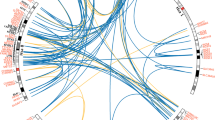Abstract
Identification of conserved genomic regions between different species is crucial for the reconstruction of their last common ancestor. Indeed, such regions of conservation in today’s species (if not due to chance) may either constitute stigmata of an ancestrally conserved region or result from a series of independent convergent events. The more phylogenetically distant the compared species are, the more we expect rearrangements and thus difficulties in finding regions of conservation. Here we decipher with strong evidence conserved genomic regions between vertebrates (human and zebrafish) and arthropods (Drosophila and Anopheles). This work includes a robust phylogenetic analysis in conjunction with a stringent statistical testing that allowed the significant rejection of a “by chance” conservation hypothesis. The conservation of gene clusters across four different species from two phylogenetically distant groups makes the hypothesis of an ancestral conservation more likely and parsimonious than the hypothesis of individual convergent events. This result shows that, in spite of more than 800 million years of divergence and evolution from their last common ancestor, we can still reveal stigmata of conservation between all these species. The last common ancestor of zebrafish, human, Drosophila, and Anopheles is the common ancestor of all protostomes and deuterostomes known as “Urbilateria.” This study reveals clusters of probably ancestrally conserved genes and constitutes an advance toward the reconstruction of the genome of Urbilateria. Thus this work allows a better understanding of the evolutionary history of metazoan genomes, including our genome.



Similar content being viewed by others
References
L Abi-Rached A Gilles T Shiina P Pontarotti H Inoko (2002) ArticleTitleEvidence of en bloc duplication in vertebrate genomes Nat Genet 31 100–105 Occurrence Handle10.1038/ng855 Occurrence Handle1:CAS:528:DC%2BD38Xjt1Kgu7k%3D Occurrence Handle11967531
A Adoutte G Balavoine N Lartillot O Lespinet B Prud’homme R Rosa Particlede (2000) ArticleTitleThe new animal phylogeny: Reliability and implications Proc Natl Acad Sci USA 97 4453–4456
SF Altschul TL Madden AA Schaffer J Zhang Z Zhang W Miller DJ Lipman (1997) ArticleTitleGapped BLAST and PSI-BLAST: A new generation of protein database search programs Nucleic Acids Res 25 3389–3402 Occurrence Handle1:CAS:528:DyaK2sXlvFyhu7w%3D Occurrence Handle9254694
S Aparicio J Chapman E Stupka et al. (2002) ArticleTitleWhole-genome shotgun assembly and analysis of the genome of Fugu rubripes Science 297 1301–1310 Occurrence Handle10.1126/science.1072104 Occurrence Handle1:CAS:528:DC%2BD38Xms1ejtr8%3D Occurrence Handle12142439
AM Boutanaev AI Kalmykova YY Shevelyov DI Nurminsky (2002) ArticleTitleLarge clusters of co-expressed genes in the Drosophila genome Nature 420 666–669 Occurrence Handle10.1038/nature01216 Occurrence Handle1:CAS:528:DC%2BD38XpsVSitbk%3D Occurrence Handle12478293
PP Calabrese S Chakravarty TJ Vision (2003) ArticleTitleFast identification and statistical evaluation of segmental homologies in comparative maps Bioinformatics 19 IssueIDSuppl 1 174–180
EGJ Danchin L Abi-Rached A Gilles P Pontarotti (2003) ArticleTitleConservation of the MHC-like region throughout evolution Immunogenetics 55 141–148
P Dehal Y Satou RK Campbell et al. (2002) ArticleTitleThe draft genome of Ciona intestinalis: insights into chordate and vertebrate origins Science 298 2157–2167 Occurrence Handle10.1126/science.1080049 Occurrence Handle1:CAS:528:DC%2BD38XpsVSkt7o%3D Occurrence Handle12481130
EM Robertis ParticleDe YA Sasai (1996) ArticleTitleA common plan for dorsoventral patterning in Bilateria Nature 380 37–40
D Durand D Sankoff (2003) ArticleTitleTests for gene clustering J Comput Biol 10 453–482
J Felsenstein (1985) ArticleTitleConfidence limits on phylogenies: An approach using the bootstrap Evolution 39 783–791
WM Fitch (1971) ArticleTitleToward defining the course of evolution: Minimum change for a specific tree topology Syst Zool 20 406–416
N Galtier M Gouy C Gautier (1996) ArticleTitleSEAVIEW and PHYLO_WIN: Two graphic tools for sequence alignment and molecular phylogeny Comput Appl Biosci 12 543–548 Occurrence Handle1:CAS:528:DyaK2sXhtlWktLw%3D Occurrence Handle9021275
G Giribet (2002) ArticleTitleCurrent advances in the phylogenetic reconstruction of metazoan evolution. A new paradigm for the Cambrian explosion? Mol Phylogenet Evol 24 345–357
X Gu Y Wang J Gu (2002) ArticleTitleAge distribution of human gene families shows significant roles of both large-and small-scale duplications in vertebrate evolution Nat Genet 31 205–209
S Hampson A McLysaght B Gaut P Baldi (2003) ArticleTitleLineUp: statistical detection of chromosomal homology with application to plant comparative genomics Genome Res 13 999–1010
RA Holt GM Subramanian A Halpern et al. (2002) ArticleTitleThe genome sequence of the malaria mosquito Anopheles gambiae Science 298 129–149 Occurrence Handle10.1126/science.1076181 Occurrence Handle1:CAS:528:DC%2BD38XnsFSgsr8%3D Occurrence Handle12364791
B Lehner JI Semple SE Brown D Counsell et al. (2004) ArticleTitleAnalysis of a high-throughput yeast two-hybrid system and its use to predict the function of intracellular proteins encoded within the human MHC class III region Genomics 83 153–167
A McLysaght K Hokamp KH Wolfe (2002) ArticleTitleExtensive genomic duplication during early chordate evolution Nat Genet 31 200–204
MJ Pebusque F Coulier D Birnbaum P Pontarotti (1998) ArticleTitleAncient large-scale genome duplications: Phylogenetic and linkage analyses shed light on chordate genome evolution Mol Biol Evol 15 1145–1159
JH Postlethwait IG Woods P Ngo-Hazelett YL Yan PD Kelly F Chu H Huang A Hill-Force WS Talbot (2000) ArticleTitleZebrafish comparative genomics and the origins of vertebrate chromosomes Genome Res 10 1890–1902 Occurrence Handle1:CAS:528:DC%2BD3MXhtF0%3D Occurrence Handle11116085
M Remm CE Storm EL Sonnhammer (2001) ArticleTitleAutomatic clustering of orthologs and in-paralogs from pairwise species comparisons J Mol Biol 314 1041–1052
G Ruvkun O Hobert (1998) ArticleTitleThe taxonomy of developmental control in Caenorhabditis elegans Science 282 2033–2041
N Saitou M Nei (1987) ArticleTitleThe neighbor-joining method: A new method for reconstructing phylogenetic trees Mol Biol Evol 4 406–425 Occurrence Handle1:STN:280:BieC1cbgtVY%3D Occurrence Handle3447015
JD Thompson TJ Gibson F Plewniak F Jeanmougin DG Higgins (1997) ArticleTitleThe CLUSTAL_X windows interface: Flexible strategies for multiple sequence alignment aided by quality analysis tools Nucleic Acids Res 25 4876–4882 Occurrence Handle10.1093/nar/25.24.4876 Occurrence Handle1:CAS:528:DyaK1cXntFyntQ%3D%3D Occurrence Handle9396791
JD Thompson DG Higgins TJ Gibson (1994) ArticleTitleCLUSTAL W: improving the sensitivity of progressive multiple sequence alignment through sequence weighting, position-specific gap penalties and weight matrix choice Nucleic Acids Res 22 4673–4680 Occurrence Handle1:CAS:528:DyaK2MXitlSgu74%3D Occurrence Handle7984417
Z Trachtulec J Forejt (2001) ArticleTitleSynteny of orthologous genes conserved in mammals, snake, fly, nematode, and fission yeast Mamm Genome 12 227–231
A Vienne J Rasmussen L Abi-Rached P Pontarotti A Gilles (2003) ArticleTitleSystematic phylogenomic evidence of en bloc duplication of the ancestral 8p11.21–8p21.3 like region Mol Biol Evol 20 1290–1298
EM Zdobnov C von Mering I Letunic et al. (2002) ArticleTitleComparative genome and proteome analysis of Anopheles gambiae and Drosophila melanogaster Science 298 149–159
Acknowledgments
We wish to thank M. Mc-Dermott, N. Xunette-Khaldi, and L. Abi-Rached for critical review of the manuscript and S. Jacob, P. Gouret, and M.E. Letzgus for their help in the partial automation of the analysis process. E.G.J.D. is a MRT (French Ministry of Research) fellow. P.P. is a CNRS (National Centre for Scientific Research) member. This work has been supported by the Université de Provence.
Author information
Authors and Affiliations
Corresponding author
Additional information
Reviewing Editor: Dr. Yves Van de Peer
Appendix
Rights and permissions
About this article
Cite this article
Danchin, E.G., Pontarotti, P. Statistical Evidence for a More Than 800-Million-Year-Old Evolutionarily Conserved Genomic Region in Our Genome. J Mol Evol 59, 587–597 (2004). https://doi.org/10.1007/s00239-004-2648-1
Received:
Accepted:
Issue Date:
DOI: https://doi.org/10.1007/s00239-004-2648-1




